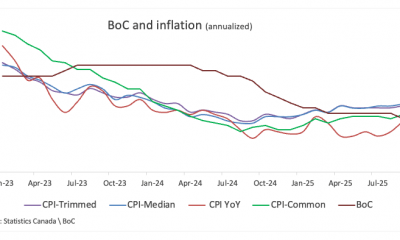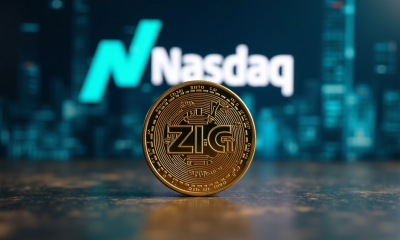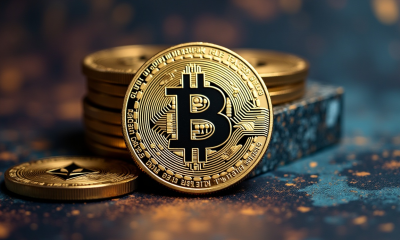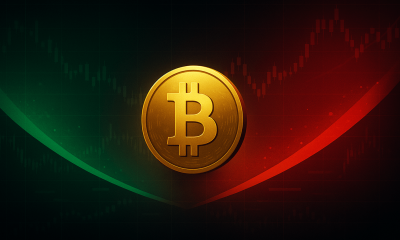

others
Japanese Yen holds position as US Dollar loses ground due to dovish Fedspeak – Crypto News
- The Japanese Yen receives downward pressure as traders expect the BoJ to delay further rate hikes.
- The BoJ Meeting Minutes highlighted a consensus among members on the need to remain vigilant regarding inflation risks.
- Traders await US Gross Domestic Product Annualized for the second quarter, scheduled for Thursday.
The Japanese Yen (JPY) remains subdued against the US Dollar (USD) following the Bank of Japan’s (BoJ) minutes from its July policy meeting released on Thursday. The JPY faces challenges as traders expect the BoJ to ponder before further rate hikes.
The BoJ Monetary Policy Meeting Minutes expressed the members’ consensus on the importance of remaining vigilant regarding the risks of inflation exceeding targets. Several members indicated that raising rates to 0.25% would be suitable as a way to adjust the level of monetary support. A few others suggested that a moderate adjustment to monetary support would also be appropriate.
The US Dollar receives downward pressure from rising odds of further interest rate cuts by the US Federal Reserve (Fed) in upcoming policy meetings. According to the CME FedWatch Tool, markets are pricing in around a 50% chance of totaling 75 basis points to be deducted by the Fed to a range of 4.0-4.25% by the end of this year.
Traders are now focused on the release of the final US Gross Domestic Product (GDP) Annualized for the second quarter (Q2) scheduled to be released later in the day. Tokyo’s inflation data will be eyed on Friday, which may provide further guidance on the economic outlook and potential monetary policy moves by the Bank of Japan.
Daily Digest Market Movers: Japanese Yen depreciates due to concerns over BoJ delaying rate hikes
- Federal Reserve Governor Adriana Kugler said on Wednesday that she “strongly supported” the Fed’s decision to cut the interest rates by a half point last week. Kugler further stated that it will be appropriate to make additional rate cuts if inflation continues to ease as expected, per Bloomberg.
- Federal Reserve Governor Michelle Bowman stated on Tuesday that key inflation indicators are still “uncomfortably above” the 2% target, urging caution as the Fed moves forward with interest rate cuts. Despite this, she expressed a preference for a more conventional approach, advocating for a quarter percentage point reduction.
- US Consumer Confidence Index fell to 98.7 in September from a revised 105.6 in August. This figure registered the biggest decline since August 2021.
- On Tuesday, BoJ Governor Kazuo Ueda indicated that the central bank has time to evaluate market and economic conditions before making any policy adjustments, signaling that there is no urgency to raise interest rates again. Ueda also noted that Japan’s real interest rate remains deeply negative, which is helping to stimulate the economy and drive up prices.
- Minneapolis Fed President Neel Kashkari said on Monday that he believes there should be and will be additional interest rate cuts in 2024. However, Kashkari expects future cuts to be smaller than the one from the September meeting, per Reuters.
- Chicago Fed President Austan Goolsbee noted, “Many more rate cuts are likely needed over the next year, rates need to come down significantly.” Additionally, Atlanta Fed President Raphael Bostic said that the US economy is close to normal rates of inflation and unemployment and the central bank needs monetary policy to “normalize” as well, per Reuters.
- On Monday, Japan’s new “top currency diplomat,” Atsushi Mimura, stated in an interview with NHK that the Yen carry trades accumulated in the past have likely been mostly unwound. Mimura cautioned that if such trades were to increase again, it could lead to heightened market volatility. “We are always monitoring the markets to ensure that does not happen,” he added.
Technical Analysis: USD/JPY breaks above the descending channel to near 145.00
USD/JPY trades around 145.00 on Thursday. Analysis of the daily chart shows that the pair has breached above the descending channel, indicating a potential for a weakening of bearish bias. Additionally, the 14-day Relative Strength Index (RSI) has moved above the 50 level, suggesting a momentum shift to bullish from bearish sentiment.
On the upside, the USD/JPY pair may explore the region around its six-week high of 149.40.
In terms of support, the USD/JPY pair may test the immediate upper boundary of the descending channel, around the 144.00 level, followed by the nine-day Exponential Moving Average (EMA) at the level of 143.62. A return to the descending channel would reinforce the bearish bias and lead the pair to target the 139.58 region, the lowest point since June 2023.
USD/JPY: Daily Chart
Japanese Yen PRICE Today
The table below shows the percentage change of Japanese Yen (JPY) against listed major currencies today. Japanese Yen was the strongest against the US Dollar.
| USD | EUR | GBP | JPY | CAD | AUD | NZD | CHF | |
|---|---|---|---|---|---|---|---|---|
| USD | -0.17% | -0.17% | -0.09% | -0.11% | -0.56% | -0.32% | -0.05% | |
| EUR | 0.17% | -0.01% | 0.08% | 0.06% | -0.39% | -0.15% | 0.13% | |
| GBP | 0.17% | 0.00% | 0.08% | 0.06% | -0.39% | -0.17% | 0.14% | |
| JPY | 0.09% | -0.08% | -0.08% | -0.00% | -0.49% | -0.27% | 0.03% | |
| CAD | 0.11% | -0.06% | -0.06% | 0.00% | -0.44% | -0.21% | 0.08% | |
| AUD | 0.56% | 0.39% | 0.39% | 0.49% | 0.44% | 0.25% | 0.52% | |
| NZD | 0.32% | 0.15% | 0.17% | 0.27% | 0.21% | -0.25% | 0.29% | |
| CHF | 0.05% | -0.13% | -0.14% | -0.03% | -0.08% | -0.52% | -0.29% |
The heat map shows percentage changes of major currencies against each other. The base currency is picked from the left column, while the quote currency is picked from the top row. For example, if you pick the Japanese Yen from the left column and move along the horizontal line to the US Dollar, the percentage change displayed in the box will represent JPY (base)/USD (quote).
RBA FAQs
The Reserve Bank of Australia (RBA) sets interest rates and manages monetary policy for Australia. Decisions are made by a board of governors at 11 meetings a year and ad hoc emergency meetings as required. The RBA’s primary mandate is to maintain price stability, which means an inflation rate of 2-3%, but also “..to contribute to the stability of the currency, full employment, and the economic prosperity and welfare of the Australian people.” Its main tool for achieving this is by raising or lowering interest rates. Relatively high interest rates will strengthen the Australian Dollar (AUD) and vice versa. Other RBA tools include quantitative easing and tightening.
While inflation had always traditionally been thought of as a negative factor for currencies since it lowers the value of money in general, the opposite has actually been the case in modern times with the relaxation of cross-border capital controls. Moderately higher inflation now tends to lead central banks to put up their interest rates, which in turn has the effect of attracting more capital inflows from global investors seeking a lucrative place to keep their money. This increases demand for the local currency, which in the case of Australia is the Aussie Dollar.
Macroeconomic data gauges the health of an economy and can have an impact on the value of its currency. Investors prefer to invest their capital in economies that are safe and growing rather than precarious and shrinking. Greater capital inflows increase the aggregate demand and value of the domestic currency. Classic indicators, such as GDP, Manufacturing and Services PMIs, employment, and consumer sentiment surveys can influence AUD. A strong economy may encourage the Reserve Bank of Australia to put up interest rates, also supporting AUD.
Quantitative Easing (QE) is a tool used in extreme situations when lowering interest rates is not enough to restore the flow of credit in the economy. QE is the process by which the Reserve Bank of Australia (RBA) prints Australian Dollars (AUD) for the purpose of buying assets – usually government or corporate bonds – from financial institutions, thereby providing them with much-needed liquidity. QE usually results in a weaker AUD.
Quantitative tightening (QT) is the reverse of QE. It is undertaken after QE when an economic recovery is underway and inflation starts rising. Whilst in QE the Reserve Bank of Australia (RBA) purchases government and corporate bonds from financial institutions to provide them with liquidity, in QT the RBA stops buying more assets, and stops reinvesting the principal maturing on the bonds it already holds. It would be positive (or bullish) for the Australian Dollar.
-

 Technology1 week ago
Technology1 week agoSam Altman says OpenAI is developing a ‘legitimate AI researcher’ by 2028 that can discover new science on its own – Crypto News
-

 Technology1 week ago
Technology1 week agoBenQ MA270U review: A 4K monitor that actually gets MacBook users right – Crypto News
-

 Technology1 week ago
Technology1 week agoGiving Nvidias Blackwell chip to China would slash USs AI advantage, experts say – Crypto News
-

 others1 week ago
others1 week agoBank of Canada set to cut interest rate for second consecutive meeting – Crypto News
-

 De-fi1 week ago
De-fi1 week agoBittensor Rallies Ahead of First TAO Halving – Crypto News
-

 Business1 week ago
Business1 week agoStarbucks Says Turnaround Strategy Drives Growth in Global Sales – Crypto News
-

 Blockchain1 week ago
Blockchain1 week agoSolana Eyes $210 Before Its Next Major Move—Uptrend Or Fakeout Ahead? – Crypto News
-

 De-fi1 week ago
De-fi1 week agoREP Jumps 50% in a Week as Dev Gets Community Support for Augur Fork – Crypto News
-

 others7 days ago
others7 days agoMETA stock has lower gaps to fill – Crypto News
-

 De-fi1 week ago
De-fi1 week agoCrypto Market Edges Lower While US Stocks Hit New Highs – Crypto News
-
others1 week ago
Pi Coin Gains Another 15% As Pi Network Joins ISO 20022 For Seamless Banking Integration – Crypto News
-

 Cryptocurrency3 days ago
Cryptocurrency3 days agoAndrew Tate Buys $5 Million Worth of Bitcoin Hours Before Crash – Crypto News
-
Cryptocurrency6 days ago
After 1,993% Burn Spike, Is Shiba Inu Price Set for a Major Trend Reversal? – Crypto News
-
others1 week ago
Crypto Market Tumbles as Jerome Powell Says December Rate Cut ‘Far From Certain’ – Crypto News
-

 De-fi1 week ago
De-fi1 week agoBitcoin Dips Under $110,000 After Fed Cuts Rates – Crypto News
-

 Cryptocurrency2 days ago
Cryptocurrency2 days agoMany Crypto Treasury Companies Were a Get-Rich-Quick Trap, Warns Columbia Professor – Crypto News
-

 De-fi1 week ago
De-fi1 week agoTokenized Nasdaq Futures Enter Top 10 by Volume on Hyperliquid – Crypto News
-

 Cryptocurrency1 week ago
Cryptocurrency1 week agoCitigroup and Coinbase partner to expand digital-asset payment capabilities – Crypto News
-

 De-fi1 week ago
De-fi1 week agoCRO Jumps After Trump’s Truth Social Announces Prediction Market Partnership with Crypto.Com – Crypto News
-
others1 week ago
Can ASTER Price Rebound 50% as Whale Activity and Bullish Pattern Align? – Crypto News
-

 Blockchain7 days ago
Blockchain7 days agoSmart Money Buys the Dip – Crypto News
-

 Cryptocurrency6 days ago
Cryptocurrency6 days agoZIGChain eyes gains as Nasdaq-Listed SEGG Media backs ZIG – Crypto News
-

 Cryptocurrency3 days ago
Cryptocurrency3 days agoAndrew Tate Buys $5 Million Worth of Bitcoin Hours Before Crash – Crypto News
-

 Cryptocurrency3 days ago
Cryptocurrency3 days agoLitecoin: $855K ETF inflow sparks new life – Next target is $105 IF… – Crypto News
-

 Cryptocurrency2 days ago
Cryptocurrency2 days agoBitcoin tests $100K support after massive liquidation event rocks market – Crypto News
-
others1 week ago
Pi Network Patterns Point to More Gains Despite Manipulation Claims – Crypto News
-
Technology1 week ago
Breaking: $2.6B Western Union Announces Plans for Solana-Powered Stablecoin by 2026 – Crypto News
-
Business1 week ago
BNB Chain’s Future Growth Won’t Come From DEXs – Crypto News
-

 Cryptocurrency1 week ago
Cryptocurrency1 week agoInside Bitwise’s milestone solana ETF launch – Crypto News
-

 Cryptocurrency1 week ago
Cryptocurrency1 week agoWhy Is Pi Network’s (PI) Price Up by Double Digits Today? – Crypto News
-

 Blockchain1 week ago
Blockchain1 week agoCZ Weighing Lawsuit Against US Senator over Money Laundering Claim: Report – Crypto News
-

 Blockchain1 week ago
Blockchain1 week agoBasel Reportedly Aims for Friendlier Crypto Bank Guidelines – Crypto News
-

 Cryptocurrency7 days ago
Cryptocurrency7 days agoIs the Market Finally Learning to Handle Volatility? – Crypto News
-

 Metaverse6 days ago
Metaverse6 days agoAI boom is just beginning – Nvidia CEO Jensen Huang explains what’s driving the virtuous cycle – Crypto News
-

 Cryptocurrency2 days ago
Cryptocurrency2 days agoStrategy IPO redefines corporate Bitcoin strategy with euro-denominated offering – Crypto News
-

 Cryptocurrency1 week ago
Cryptocurrency1 week agoKERNEL price goes vertical on Upbit listing, hits $0.23 – Crypto News
-

 Blockchain1 week ago
Blockchain1 week agoVisa To Support Four Stablecoins on Four Blockchains – Crypto News
-

 Cryptocurrency1 week ago
Cryptocurrency1 week agoArbitrum beats Ethereum in inflows: Yet ARB price lags – Here’s why – Crypto News
-

 Technology1 week ago
Technology1 week agoEthereum Foundation launches institutional portal to boost enterprise adoption – Crypto News
-
Business1 week ago
Bitcoin Price Forecast as Trump Cuts Tariffs After US-China Trade Deal – Crypto News
-
Technology1 week ago
XRP Price Outlook as ETF Nears Possible November 13 Launch – Crypto News
-
Business1 week ago
Not L1s or Wallets – Who Generates the Bulk of Crypto’s $20B in Revenue? – Crypto News
-
others6 days ago
Pi Coin Price Prediction After AI Investment Announcement – Is a Bull Run Ahead? – Crypto News
-
Technology1 week ago
Breaking: $2.6B Western Union Announces Plans for Solana-Powered Stablecoin by 2026 – Crypto News
-
others1 week ago
When liquidity becomes the new frontier – Crypto News
-

 Blockchain1 week ago
Blockchain1 week agoBitcoin Cost Basis Map Reveals Key War Zone Between Bulls & Bears – Crypto News
-
others1 week ago
Cardano Price Risks 20% Crash Amid Death Cross and Falling ADA ETF Odds – Crypto News
-
Technology1 week ago
Canary XRP ETF Filing Removes SEC Delay Clause, Targets November Launch – Crypto News
-
others6 days ago
Russia S&P Global Manufacturing PMI dipped from previous 48.2 to 48 in October – Crypto News
-

 Cryptocurrency6 days ago
Cryptocurrency6 days agoHBAR under pressure, Descending channel hints at 24% downside move – Crypto News




